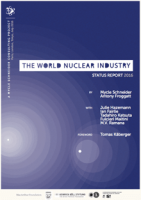The World Nuclear Industry Status Report 2016

The World Nuclear Industry Status Report 2016 (WNISR) provides a comprehensive overview of nuclear power plant data, including information on operation, production and construction. The WNISR assesses the status of new-build programs in current nuclear countries as well as in potential newcomer countries. The WNISR2016 edition includes again an assessment of the financial status of many of the biggest industrial players in the sector. This edition also provides a Chernobyl Status Report, 30 years after the accident that led to the contamination of a large part of Europe. The Fukushima Status Report gives an overview of the standing of onsite and offsite issues five years after the beginning of the catastrophe. Key findings:
The China Effect
• Nuclear power generation in the world increased by 1.3%, entirely due to a 31% increase in China.
• Ten reactors started up in 2015—more than in any other year since 1990—of which eight were in China. Construction on all of them started prior to the Fukushima disaster.
• Eight construction starts in the world in 2015—to which China contributed six—down from 15 in 2010 of which 10 were in China. No construction starts in the world in the first half of 2016.
• The number of units under construction is declining for the third year in a row, from 67 reactors at the end of 2013 to 58 by mid-2016, of which 21 are in China.
• China spent over US$100 billion on renewables in 2015, while investment decisions for six nuclear reactors amounted to US$18 billion.
Early Closures, Phase-outs and Construction Delays
• Eight early closure decisions taken in Japan, Sweden, Switzerland, Taiwan and the U.S.
• Nuclear phase-out announcements in the U.S. (California) and Taiwan.
• In nine of the 14 building countries all projects are delayed, mostly by several years. Six projects have been listed for over a decade, of which three for over 30 years. China is no exception here, at least 10 of 21 units under construction are delayed.
• With the exception of United Arab Emirates and Belarus, all potential newcomer countries delayed construction decisions. Chile suspended and Indonesia abandoned nuclear plans.
Nuclear Giants in Crisis – Renewables Take Over
• AREVA has accumulated US$11 billion in losses over the past five years. French government decides €5.6 billion bailout and breaks up the company. Share value 95 percent below 2007 peak value. State utility EDF struggles with US41.5 billion debt, downgraded by S&P. Chinese utility CGN, EDF partner for Hinkley Point C, loses 60% of its share value since June 2015.
• Globally, wind power output grew by 17%, solar by 33%, nuclear by 1.3%.
• Brazil, China, India, Japan and the Netherlands now all generate more electricity from wind turbines alone than from nuclear power plants.
Chernobyl+30/Fukushima+5
• Three decades after the Chernobyl accident shocked the European continent, 6 million people continue to live in severely contaminated areas. Radioactive fallout from Chernobyl contaminated 40% of Europe's landmass. A total of 40,000 additional fatal cancer cases are expected over the coming 50 years.
• Five years after the Fukushima disaster began on the east coast of Japan, over 100,000 people remain dislocated. Only two reactors are generating power in Japan, but final closure decisions were taken on an additional six reactors that had been offline since 2010-11.

